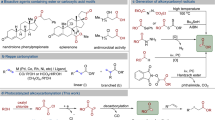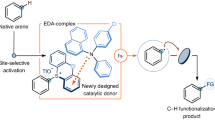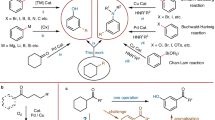Abstract
This protocol describes a practical procedure for the preparation of terpyridine carboxy derivatives, which have numerous applications, including being photoactive components of functional materials, and which can be used in medicinal chemistry or in catalysis. This protocol relies on the permanganate-mediated oxidation of a furan ring on the polypyridine system. The procedure involves three stages. First, a furan-functionalized terpyridine is synthesized from furfuraldehyde and a 2-acetylpyridine derivative. Second, the furan ring is oxidized thus providing a carboxylic acid. Finally, esters are prepared by reaction of the acids in refluxing alcohols. The procedure is simple, uses a reagent available from renewable resources (furfural) and avoids the use of noxious reagents or solvents, thus making it more environmentally friendly when compared with previously described methods. The whole protocol can be conducted in ∼10 d, including isolation and drying of intermediates and products.
This is a preview of subscription content, access via your institution
Access options
Subscribe to this journal
Receive 12 print issues and online access
$259.00 per year
only $21.58 per issue
Buy this article
- Purchase on Springer Link
- Instant access to full article PDF
Prices may be subject to local taxes which are calculated during checkout






Similar content being viewed by others
References
Morgan, S.G. & Burstall, F.H. Dehydrogenation of pyridine of anhydrous ferric chloride. J. Chem. Soc. 1, 20–30 (1932).
Schubert, U.S., Hofmeier, H. & Newkome, G.R. Modern Terpyridine Chemistry (Wiley, 2006).
Schubert, U.S., Winter, A. & Newkome, G.R. Terpyridine-based Materials (Wiley, 2011).
O'Regan, B. & Grätzel, M. A Low cost, high efficiency solar-cell based on dye-sensitized colloidal TiO2 films. Nature 353, 737–740 (1991).
Kalyanasundaram, H. & Grätzel, M. Application of functionalized transition metal complexes in photonic and optoelectronic devices. Coord. Chem. Rev. 77, 347–414 (1998).
Bomben, P.G., Robson, K.C.D., Koivisto, B.D. & Berlinguette, C.P. Cyclometalated ruthenium chromophores for the dye-sensitized solar cell. Coord. Chem. Rev. 256, 1438–1450 (2012).
Yin, J.-F., Velayudham, M., Bhattacharya, D., Lin, H.-C. & Lu, K.L. Structure optimization of ruthenium photosensitizers for efficient dye-sensitized solar cells–a goal toward a 'bright' future. Coord. Chem. Rev. 256, 3008–3035 (2012).
Ito, A. et al. Mass spectrometric analysis using ruthenium (II)-labeling for identification of glycosyl hydrolase product. Biosci. Biotechnol. Biochem. 73, 428–430 (2009).
Luo, H.-G. et al. Synthesis of porphyrin-appended terpyridine as a chemosensor for cadmium based on fluorescent enhancement. Talanta 72, 575–581 (2007).
Zhang, N., Yang, J., Hu, R.-X. & Zhang, M.-B. Syntheses and structures of terpyridine-metal complexes. Z. Anorg. Allg. Chem. 639, 197–202 (2013).
Nazeeruddin, M.K. et al. Engineering of efficient panchromatic sensitizers for nanocrystalline TiO2-based solar cells. J. Am. Chem. Soc. 123, 1613–1624 (2001).
Fallahpour, R.-A. Carboxylate derivatives of oligopyridines. Synthesis 8, 1138–1142 (2000).
El-ghayoury, A. & Ziessel, R. Facile synthesis of polypyridine esters: a route to functionalized aldehydes. J. Org. Chem. 65, 7757–7763 (2000).
Kitamura, Y. et al. Template-directed formation of luminescent lanthanide complexes: versatile tools for colorimetric identification of single-nucleotide polymorphism. J. Inorg. Biochem. 102, 1921–1931 (2008).
Husson, J., Beley, M. & Kirsch, G. A novel pathway for the synthesis of a carboxylic acid-functionalised Ru(II) terpyridine complex. Tetrahedron Lett. 44, 1767–1770 (2003).
Husson, J. & Knorr, M. Syntheses and applications of furanyl-functionalised 2,2′:6′,2″-terpyridines. Beilstein J. Org. Chem. 8, 379–389 (2012).
Mamman, A.S. et al. Furfural: hemicelluloses/xylose derived biochemical. Biofuels Bioprod. Biorefin. 2, 438–454 (2008).
Dehaudt, J., Husson, J. & Guyard, L. A more efficient synthesis of 4,4′,4″-tricarboxy-2,2′:6′,2″-terpyridine. Green Chem. 13, 3337–3340 (2011).
Raboin, J.-C., Kirsch, G. & Beley, M. On the way to unsymmetrical terpyridines carrying carboxylic acids. J. Heterocyclic Chem. 37, 1077–1080 (2000).
Wolpher, H. et al. Synthesis and electron transfer studies of ruthenium-terpyridine-based dyads attached to nanostructured TiO2 . Inorg. Chem. 46, 638–651 (2007).
Constable, E.C. et al. Expanded ligands: bis(2,2′: 6′,2″-terpyridine carboxylic acid) ruthenium(II) complexes as metallosupramolecular analogues of dicarboxylic acids. Dalton Trans. 38, 4323–4332 (2007).
Duprez, V., Biancardo, M. & Krebs, F.C. Characterisation and application of new carboxylic acid-functionalised ruthenium complexes as dye-sensitisers for solar cells. Solar Energy Mater. Solar Cells 91, 230–237 (2007).
Cooke, M.W., Tremblay, P. & Hanan, G.S. Carboxy-derived (tpy)2Ru2+ complexes as sub-units in supramolecular architectures: The solubilized ligand 4′-(4-carboxyphenyl)-4,4″-di-(tert-butyl)tpy and its homoleptic Ru(II) complex. Inorg. Chim. Acta 361, 2259–2269 (2008).
Cooke, M.W. et al. Spanning Pairs of Rh2(acetate)4 Units with Ru(II) Complexes. Inorg. Chem. 47, 6112–6114 (2008).
Jarosz, P. et al. Platinum(II) terpyridyl acetylide complexes on platinized TiO2: toward the photogeneration of H2 in aqueous media. Inorg. Chem. 48, 9653–9663 (2009).
Koivisto, B.D., Robson, K.C.D. & Berlinguette, C.P. Systematic manipulation of the light-harvesting properties for tridentate cyclometalated Ruthenium (II) complexes. Inorg. Chem. 48, 9644–9652 (2009).
Cooke, M.W., Santoni, M.-P., Hanan, G.S., Proust, A. & Hasenknopf, B. A divergent strategy for covalently-tethered (tpy)2Ru(II) systems based on Rh2(N,N′-diphenylbenzamidinates)4 . Dalton Trans. 19, 3671–3673 (2009).
Caramori, S. et al. Combination of cobalt and iron polypyridine complexes for improving the charge separation and collection in Ru(terpyridine)2-sensitised solar cells. Chem. Eur. J. 16, 2611–2618 (2010).
Santoni, M.P., Pal, A.K., Hanan, G.S., Proust, A. & Hasenknopf, B. Discrete covalent organic-inorganic hybrids: terpyridine functionalized polyoxometalates obtained by a modular strategy and their metal complexation. Inorg. Chem. 50, 6737–6745 (2011).
Shinpuku, Y., Inui, F., Nakai, M. & Nakabayashi, Y. Synthesis and characterization of novel cyclometalated iridium(III) complexes for nanocrystalline TiO2-based dye-sensitized solar cells. J. Photochem. Photobiol. A Chem. 222, 203–209 (2011).
Kimura, M. et al. Improvement of TiO2/Dye/electrolyte interface conditions by positional change of alkyl chains in modified panchromatic Ru complex dyes. Chem. Eur. J. 19, 1028–1034 (2013).
Ozawa, H., Yamamoto, Y., Fukushima, K., Yamashita, S. & Arakawa, H. Synthesis and characterization of a novel ruthenium sensitizer with a hexylthiophene-functionalized terpyridine ligand for dye-sensitized solar cells. Chem. Lett. 42, 897–899 (2013).
Wang, J. & Hanan, G.S. A facile route to sterically hindered and non-hindered 4′-aryl-2,2′:6′,2″-terpyridines. Synlett 8, 1251–1254 (2005).
Hernandez-Redondo, A. Copper (I) polypyridine complexes: the sensitizers of the future for dye-sensitized solar cells (DSSCs). Ph.D. Thesis, Basel University (2009).
Van Aken, K., Strekowski, L. & Patiny, L. EcoScale, a semi-quantitative tool to select an organic preparation based on economical and ecological parameters. Beilstein J. Org. Chem. 2, 3 (2006).
Acknowledgements
Ville de Besançon is acknowledged for a doctoral grant to J.D. Université de Franche-Comté is acknowledged for financial support through project Bonus Qualité Recherche (BQR) Rebiocell. We would like to thank Dr. I. Jourdain for recording NMR spectra of compounds 7 and 8.
Author information
Authors and Affiliations
Contributions
J.H. supervised the project, developed the protocol for compound 7, reproduced experiments for compound 8 and wrote the manuscript. J.D. developed the protocol for compound 8. L.G. supervised the project, recorded some analysis and brought assistance in manuscript writing.
Corresponding author
Ethics declarations
Competing interests
The authors declare no competing financial interests.
Integrated supplementary information
Supplementary information
Supplementary Figure 1
Picture of TLC plate of compounds 7 and 8. (PDF 338 kb)
Supplementary Data 1
1H NMR spectrum of compound 7. (PDF 175 kb)
Supplementary Data 2
IR spectrum of compound 7. (PDF 338 kb)
Supplementary Data 3
1H NMR spectrum of compound 8. (PDF 169 kb)
Supplementary Data 4
IR spectrum of compound 8. (PDF 322 kb)
Rights and permissions
About this article
Cite this article
Husson, J., Dehaudt, J. & Guyard, L. Preparation of carboxylate derivatives of terpyridine via the furan pathway. Nat Protoc 9, 21–26 (2014). https://doi.org/10.1038/nprot.2013.162
Published:
Issue Date:
DOI: https://doi.org/10.1038/nprot.2013.162
This article is cited by
-
Molecular demultiplexer as a terminator automaton
Nature Communications (2018)
Comments
By submitting a comment you agree to abide by our Terms and Community Guidelines. If you find something abusive or that does not comply with our terms or guidelines please flag it as inappropriate.



